![]()
Author & Artist Corner: Artist
Kelly Murphy
|
While growing up in southeastern New England, Kelly Murphy was surrounded by an abundance of flora and fauna. It was not until recently that she became more fascinated with urban areas and their intricate mazes of buildings and streets. When illustrating these cityscapes, she resorts to the wooden building blocks she would play with as a young girl. Kelly loved to see how tall and uniquely shaped the buildings could get before eventually toppling over. |
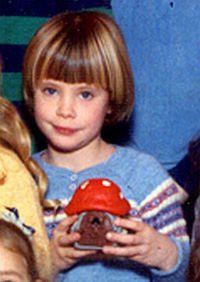 |
| Kelly at age 7 |
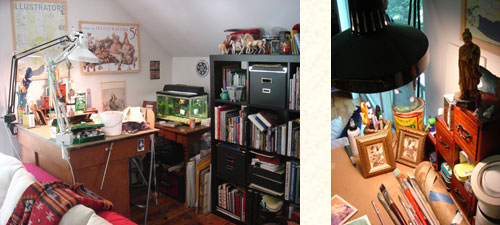 |
|
| Kelly's studio |
Creating my Cricket Cover
Here are a few of the sketches I created while throwing around ideas for this month's Cricket. The editors were attracted by my mystical cityscapes, which they saw in my online portfolio, and asked me to create something similar, something fantastical with a Middle Eastern flavor, since since that was the setting for several of the issue's stories.
I thought of Marduk's dragon. Marduk was the Babylonian name of a late-generation god from ancient Mesopotamia and patron deity of the city of Babylon. 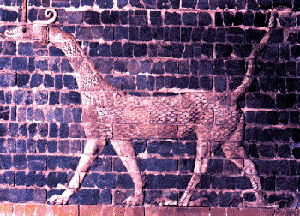 The mythical Dragon of Marduk, with scaly body, serpent's head, viper's horns, front feet of a feline, hind feet of a bird, and a scorpion's tail, can be seen on the famous Istar Gates. King Nebuchadnezzar ornamented the monumental entrance gate dedicated the goddess of love and war, and the processional street leading to it, with scores of pacing glazed brick animals. On the gate were alternating tiers of Marduk's dragons and bulls of the weather god Adad. Along the street were the lions sacred to Ishtar. All of this brilliant decoration was designed to create a ceremonial entrance for the king in religious procession on the most important day of the New Year's Festival.
The mythical Dragon of Marduk, with scaly body, serpent's head, viper's horns, front feet of a feline, hind feet of a bird, and a scorpion's tail, can be seen on the famous Istar Gates. King Nebuchadnezzar ornamented the monumental entrance gate dedicated the goddess of love and war, and the processional street leading to it, with scores of pacing glazed brick animals. On the gate were alternating tiers of Marduk's dragons and bulls of the weather god Adad. Along the street were the lions sacred to Ishtar. All of this brilliant decoration was designed to create a ceremonial entrance for the king in religious procession on the most important day of the New Year's Festival.
Here's the progression into the final cover. Obviously, the Babylonian referrence was a bit too obscure, but still cool to research and learn along the way.
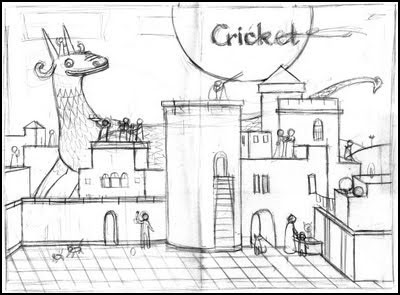
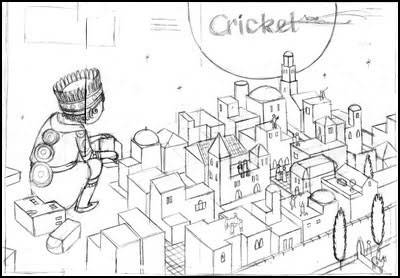
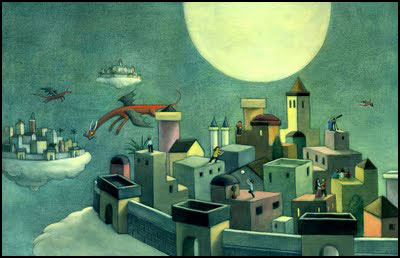
Click "Add new comment" below to ask Kelly a question.




I have a question. What is the best advice you have on becoming an author/artist? I love to write, and right now I am writing a story called Across The Anger Fields. It is a work of progress and I can not wait until I finish it.
(November 2, 2009 - 7:17 pm)
Hi Choco,
Thanks so much for your question! The most important piece of advice I might have for aspiring writers (and illustrators) is to not give up! It sounds pretty simple, and I am sure you've heard it from your teachers, parents, and coaches already. Having determination is the most important ingredient for success. One other recommendation is to write (or make artwork) about what you like and know the best! Louisa May Alcott taught me that lesson in her book "Little Women". With your knowledge and passion, you can improve your writing skills, and also keep your interest and confidence level high, so you will share your work with everyone. From there, your interests will widen and grow even stronger.
Thanks again for you question, and keep at it! Your book title sounds alluring already.
Kelly
(November 3, 2009 - 3:23 pm)
Soon I am going to post it on Chatterbox. Maybe you could read it when I do! Thank you for your advice. I also have another question:What are your other hobbies?
(November 6, 2009 - 4:08 pm)
Hello again Choco,
That sounds like a great idea to get some feedback and responses from other aspiring writers. Good for you! Let me know, it'd be fun to take a read through. My other hobbies? Hmmm, let's see... I really like winter sports (skiing and skating), hiking, and more frequently hanging out with my animals. Thanks for asking!
(November 9, 2009 - 11:46 am)
Oh, I have had the same questions for a long time! I have been a huge fan of Cricket for a long time now. I am currently working on a murder/kidnapping piece, titled(so far) Fatal Mistake. I have always had the most trouble with titles, so, my question is: What do you think?
(January 28, 2010 - 1:54 am)
Hello, Kelly,
Do you have any advice for someone like me who can't seem to get what I mean to draw on paper? Today I was just drawing a picture of Cymbril and Loric-characters from Frederic S. Durbin's The Star Shard- and it did not look good at all, Cymbril was like 3 times larger than Loric, and I can never get noses to look right. Any help? Or am I doomed to be like this forever?
(November 6, 2009 - 7:49 pm)
Same with me. Faces are my low point, and it's really putting me down, because I come from a very artistic family. :)
I love your work. It's really inspiring. :) Thanks for doing the cover this month!!
-L
(November 7, 2009 - 3:01 pm)
Hi Laura,
Faces are tough for everyone, so no worries! Artist eventually develop a style so they have a way of drawing that looks cohesive, or similar form drawing to drawing. Faces are how we identify friends, family members, and strangers. You want to be able to make an exact representation, and if you're not getting the right proportions, it can be very frustrating. Like I had mentioned to Hannah, keep things in big shapes at first. Then start to measure where the eyes are on the head: Are they in the middle? A bit higher than middle? Are they far apart or close together? Does the mouth stretch beyond the whole nose? Is it close to the nose or lower towards the chin? Constantly go around the face seeing if these simple objects are in the right place first, then you can "tighten up" on the details.
As far as developing a style, it's not something you copy or force, buy or steal. It's simply a way an artist "sees". How I think this develops is through your inspirations. We're naturally drawn to certain illustratons, stories, music, hobbies... so if you recognize what it is about them that you like, you can use it to inspire your artwork. I really liked fantasy illustrations when I was younger, and a lot of japanese animation shows my brothers watched. After studying how they drew their characters or how fantasy illustration created wonderful atmostphere in their pictures, I then tried to include some of that into my own work, letting my own flavor blend, too. Like I said before... keep practicing, and you'll see wonderful things happen! Even after all the years I've been illustrating, it's still tough to draw somethings! It takes a lot of sketching before I can get to a finished drawing, trust me!
Keep up the intense observation and thanks so much for your kind works about my work!
(November 9, 2009 - 12:28 pm)
Thank you so much. It's very encouraging to speak to a published illustrator. I'll try my hardest to not try so hard, if that makes any sense! I compare my work to others' too often. I need to work on my own stuff, like you said, not make it look like someone else's. Again, thank you very much.
-L
(November 15, 2009 - 1:12 am)
Hi Hannah P!
Well, you're already taking a step in the right direction by practicing. Remember when you were younger, and you'd love to draw anything and you wouldn't be worried if it looked "right"? Sometimes when you draw, it's easy to get too frustrated and insecure about making it look right. I'd suggest a few things. Try looking at your subject, and first draw it in simple shapes. For instance, if you are drawing a horse... the torso is sort of like a thick sausage, and the neck is half a moon... so on and so forth. That way, you can keep looking at the proportions between the shapes without being concerned about the smaller details. When you start with the small details first, you are more likely not looking at the overall shape, and not willing to erase and start over.
What also is common when drawing, we have a preconceived idea of what things look like. This might be why you "can't draw noses". If you just slow down, erase what you think a nose SHOULD look like, and just see it for a funny shape, it makes you concentrate on the lines. I hope this makes sense. Just keep drawing! Just like everything else, you need to practice in order to improve your skills.
Here's a fun trick! Take a drawing you'd like to copy, turn it upside down, and try drawing it that way. You'll be surprised at home it might come out!
Good luck!
(November 9, 2009 - 12:08 pm)
Dear Hannah,
What I always find interesting is that if you want to have a masterpiece of art you have to let you marker/pencilpaintbrush lead you.
Grace
(February 7, 2010 - 1:52 pm)
Hi Kelly! Do you have any tips for me as an artist? I have a little bit of a problem when it comes to realistic charecters. I am great at cartoons though!
(November 14, 2009 - 9:00 am)
Hi Kirsten,
The best advice I might have is to just relax, and enjoy drawing. Sometimes it's easy to get overwhlemed and frustrated that a drawing might not be going well. As mentioned before, first recognize the bigger shapes that an object has. Often, we want to just draw the outline, but it's necessary to get the overall shapes in order to get the proportions of the whole subject. Keep your sketching light and loose, then as you get comfortable with the general shape, you can start with the smaller details. Make sure to work on all areas of a drawing, and try not to concentrate on one section for too long.
Hope these tips help, and keep drawing! I love carrying my sketchbook everywhere.
(November 16, 2009 - 12:15 pm)
I have been working on drawing still life drawings. The only thing I am struggling with is the angle. I can never get it to look like from where I am sitting. it always looks like it's from a top view or something.
Oh, also shadows.
(November 17, 2009 - 8:45 pm)
Hi Lauren,
Perspective is really tough, which is another word for "angles". Picking the right vanishing point the direction of the line of sight can always counter what you think instinctively. Some of the renaissance masters (such as Donatello) used alot of one point landscape perspective. Sometimes taking a look at some of the classic paintings can help you see how geometric and mathematical perspective can be. I also enjoy looking at "incorrect" perspective. Medieval drawings and the Mannerist paintings are really unique with their stylization.
Ultimately, keep sketching and drawing these still life object, but try and draw with only seeing the shape you want to describe. Sometimes drawing a can or a vase will come out how we see the symbol being drawn instead of the perspective you are seeng it at. if you tell yourself "this is just a collection of shapes and not a can" maybe you can get that preconceived picture out of your head. Hope this helps.
(November 30, 2009 - 7:18 pm)